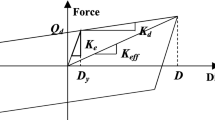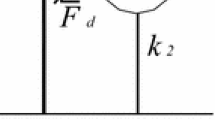Abstract
Large tanks are extensively used for storing water, petrochemicals and fuels. Since they are often cited in earthquake-prone areas, the safe and continuous operation of these important structures must be ensured even when severe earthquakes occur, since their failure could have devastating financial and socio-environmental consequences. Base-isolation has been widely adopted for the efficient seismic protection of such critical facilities. However, base-isolated tanks can be located relatively close to active faults that generate strong excitations with special characteristics. Consequently, viscous dampers can be incorporated into the isolation system to reduce excessive displacement demands and to avoid overconservative isolator design. Nonetheless, only a few studies have focused on the investigation of seismic response of base-isolated liquid storage tanks in conjunction with supplemental viscous dampers. Therefore, the impact of the addition of supplemental linear viscous dampers on the seismic performance of tanks isolated by single friction pendulum devices is investigated herein. Four levels of supplemental damping are assessed and compared with respect to isolators’ displacement capacity and accelerations that are transferred to the tanks.
Similar content being viewed by others
References
API 650 (2007), Welded Tanks for Oil Storage, 11th Edition, American Petroleum Institute.
Bakalis K, Fragiadakis M and Vamvatsikos D (2017a), “Surrogate Modeling for the Seismic Performance Assessment of Liquid Storage Tanks,” Journal of Structural Engineering, 143(4): 1–13.
Bakalis K, Vamvatsikos D and Fragiadakis M (2017b), “Seismic Risk Assessment of Liquid Storage Tanks via a Nonlinear Surrogate Model,” Earthquake Engineering and Structural Dynamics, 46(15): 2851–2868.
Bakalis K, Vamvatsikos D, Grant DN and Mistry A (2019), “Downtime Assessment of Base-Isolated Liquid Storage Tanks,” SECED Conference, Greenwich, London, UK.
Baker JW (2015), “Efficient Analytical Fragility Function Fitting Using Dynamic Structural Analysis,” Earthquake Spectra, 31(1): 579–599.
Billah AHM and Alam M (2015), “Seismic Fragility Assessment of Concrete Bridge Pier Reinforced with Superelastic Shape Memory Alloy,” Earthquake Spectra, 31(3): 1515–1541.
Castaldo P, Amendola G and Ripani M (2018), “Seismic Fragility of Structures Isolated by Single Concave Sliding Devices for Different Soil Conditions,” Earthquake Engineering and Engineering Vibration, 17(4): 849–867.
Castellano GM, Infanti S, Dumoulin C, Ducoup L, Martelli A and Dusi A (2000), “Shaking Table Tests on a Liquefied Natural Gas Storage Tank Mock-Up Seismically Protected with Elastomeric Isolators and Steel Hysteretic Torsional Dampers,” Proceedings of the 12th World Conference on Earthquake Engineering, Auckland, New Zealand.
CEN (2006), Eurocode 8 — Design of Structures for Earthquake Resistance. Part 4: Silos, Tanks and Pipelines, European Committee for Standardization, Brussels.
Christovasilis IP and Whittaker AS (2008), “Seismic Analysis of Conventional and Isolated LNG Tanks Using Mechanical Analogs,” Earthquake Spectra, 24(3): 599–616.
Constantinou M, Mokha A and Reinhorn A (1990), “Teflon Bearings in Base Isolation, II: Modelling,” Journal of Structural Engineering, 116(2): 455–474.
Constantinou MC, Kalpakidis I, Filiatrault A and Ecker Lay RA (2011), “LRFD-Based Analysis and Design Procedures for Bridge Bearings and Seismic Isolators,” Technical Report MCEER-11-0004, University at Buffalo, State University of New York, USA.
CSI Computers and Structures (2017), SAP2000 Version 20 — Integrated Software for Structural Analysis and Design, Computers and Structures Inc.
De Angelis M, Giannini R and Paolacci F (2010), “Experimental Investigation on the Seismic Response of a Steel Liquid Storage Tank Equipped with Floating Roof by Shaking Table Tests,” Earthquake Engineering and Structural Dynamics, 39(4): 377–396.
De Domenico D, Gandelli E and Quaglini V (2020), “Adaptive Isolation System Combining Low-Friction Sliding Pendulum Bearings and SMA-Based Gap Dampers,” Engineering Structures, 212: 110536.
Eidinger J, Avila E, Ballantyne D, Cheng L, der Kiureghian A, Maison B, et al. (2001), Seismic Fragility Formulations for Water Systems, Part 1 — Guidelines, American Lifelines Alliance, USA.
EPS (2019), Earthquake Protection Systems, Available Online: www.earthquakeprotection.com. (accessed March 2019)
Gandelli E, Penati M, Quaglini V, Lomiento G, Miglio E and Benzoni GM (2019), “A Novel OpenSees Element for Single Curved Surface Sliding Isolators,” Soil Dynamics and Earthquake Engineering, 119: 433–453.
Gazi H, Kazezyilmaz-Alhan CM, and Alhan C (2015), “Behavior of Seismically Isolated Liquid Storage Tanks Equipped with Nonlinear Viscous Dampers in Seismic Environment,” Proceedings of the 10th Pacific Conference on Earthquake Engineering, Building an Earthquake-Resilient Pacific, 6–8 November, Sydney, Australia.
Hall JF (1999), “Discussion — The Role of Damping in Seismic Isolation,” Earthquake Engineering and Structural Dynamics, 28(12): 1717–1720.
Hamdan FH (2000), “Seismic Behaviour of Cylindrical Steel Liquid Storage Tanks,” Journal of Constructional Steel Research, 53(3): 307–333.
Haroun MA (1983), “Vibration Studies and Tests of Liquid Storage Tanks,” Earthquake Engineering and Structural Dynamics, 11(2): 179–206.
Haroun MA and Tayel MA (1985), “Response of Tanks to Vertical Seismic Excitations,” Earthquake Engineering and Structural Dynamics, 13(5): 583–595.
Hatzigeorgiou GD and Pnevmatikos NG (2014), “Maximum Damping Forces for Structures with Viscous Dampers Under Near-Source Earthquakes,” Engineering Structures, 68: 1–13.
Housner G (1957), “Dynamic Pressures on Accelerated Fluid Containers,” Bulletin of the Seismological Society of America, 47(1): 15–35.
IITK-GSDMA (2007), Guidelines for Seismic Design of Liquid Storage Tanks — Provisions with Commentary and Explanatory Examples, National Information Center of Earthquake Engineering, Kanpur, India.
Jadhav MB and Jangid RS (2006), “Response of Base-isolated Liquid Storage Tanks to Near-fault Motions,” Structural Engineering and Engineering Mechanics, 23(6): 615–634.
Kaneko M, Tamura K, Maebayashi K and Sarnta M (1990), “Earthquake Response Characteristics of Base-Isolated Buildings,” Proceedings of the 4th US National Conference of Earthquake Engineering, Vol. 3, Palm Springs, California, pp. 569–578.
Konstandakopoulou FD and Hatzigeorgiou GD (2017), “Water and Wastewater Steel Tanks Under Multiple Earthquakes,” Soil Dynamics and Earthquake Engineering, 100: 445–453.
Kumar H and Saha SK (2021), “Seismic Performance of Base-isolated Elevated Liquid Storage Tanks Considering Soil—Structure Interaction,” Practice Periodical on Structural Design and Construction, 26(1): 04020062.
Lafontaine M, Moroni O, Sarrazin M and Roscke P (2009), “Optimal Control of Accelerations in a Base-Isolated Building Using Magnetorheological Dampers and Genetic Algorithms,” Journal of Earthquake Engineering, 13(8): 1153–1171.
Li Y, Li S and Chen Z (2021), “Optimal Design and Effectiveness Evaluation for Inerter-Based Devices on Mitigating Seismic Responses of Base Isolated Structures,” Earthquake Engineering and Engineering Vibration, 20(4): 1021–1032.
Loghman V, Khoshnoudian F and Banazadeh M (2015), “Effect of Vertical Component of Earthquake on Seismic Responses of Triple Concave Friction Pendulum Base-Isolated Structures,” Journal of Vibration and Control, 21(11): 2099–2113.
Lu LY, Lin CC and Lin GL (2013), “Experimental Evaluation of Supplemental Viscous Damping for a Sliding Isolation System Under Pulse-Like Base Excitations,” Journal of Sound and Vibration, 332(8): 1982–1999.
Luo H, Zhang R and Weng D (2016), “Mitigation of Liquid Sloshing in Storage Tanks by Using a Hybrid Control Method,” Soil Dynamics and Earthquake Engineering, 90: 183–195.
Malhotra PK (1997), “Seismic Response of Soil-Supported Unanchored Liquid-Storage Tanks,” Journal of Structural Engineering, 123(4): 440–450.
Malhotra PK, Wenk T and Wieland M (2000), “Simple Procedure for Seismic Analysis of Liquid-Storage Tanks,” Structural Engineering International, 10(3): 197–201.
Mazza F and Vulcano A (2009), “Nonlinear Response of RC Framed Buildings with Isolation and Supplemental Damping at the Base Subjected to Near-Fault Earthquakes,” Journal of Earthquake Engineering, 13(5): 690–715.
Mehrparvar B and Khoshnoudian T (2012), “Performance-Based Semi-Active Control Algorithm for Protecting Base Isolated Buildings from Near-fault Earthquakes,” Earthquake Engineering and Engineering Vibration, 11(1): 43–55.
Mori C, Sorace S and Terenzi G (2015), “Seismic Assessment and Retrofit of Two Heritage-Listed R/C Elevated Water Storage Tanks,” Soil Dynamics and Earthquake Engineering, 77: 123–136.
Nepal S and Saitoh M (2020), “Improving the Performance of Conventional Base Isolation Systems by an External Variable Negative Stiffness Device Under Near-fault and Long-Period Ground Motions,” Earthquake Engineering and Engineering Vibration, 19(4): 985–1003.
NZSEE (2009), Seismic Design of Storage Tanks, New Zealand Society of Earthquake Engineering.
Paolacci F (2015), “On the Effectiveness of Two Isolation Systems for the Seismic Protection of Elevated Tanks,” Journal of Pressure Vessel Technology, 137(3): 1–8.
Pranesh M and Sinha R (2000), “VFPI: an Isolation Device for Aseismic Design,” Earthquake Engineering and Structural Dynamics, 29(5): 603–627.
Providakis CP (2009), “Effect of Supplemental Damping on LRB and FPS Seismic Isolators Under Near-Fault Ground Motions,” Soil Dynamics and Earthquake Engineering, 29(1): 80–90.
Ribakov Y (2010), “Reduction of Structural Response to Near Fault Earthquakes by Seismic Isolation Columns and Variable Friction Dampers,” Earthquake Engineering and Engineering Vibration, 9(1): 113–122.
Roy BK, Chakraborty S and Mishra SK (2014), “Robust Optimum Design of Base Isolation System in Seismic Vibration Control of Structures Under Uncertain Bounded System Parameters,” Journal of Vibration and Control, 20(5): 786–800.
Saha SK, Matsagar V and Chakraborty S (2016), “Uncertainty Quantification and Seismic Fragility of Base-Isolated Liquid Storage Tanks Using Response Surface Models,” Probabilistic Engineering Mechanics, 43: 20–35.
Salzano E, Iervolino I and Fabbrocino G (2003), “Seismic Risk of Atmospheric Storage Tanks in the Framework of Quantitative Risk Analysis,” Journal of Loss Prevention in the Process Industries, 16(5): 403–409.
Sarlis AA and Constantinou MC (2010), “Modeling Triple Friction Pendulum Isolators in Program SAP2000,” Document Distributed to the Engineering Community Together with Executable Version of Program and Example Files, Supplement to MCEER Report 05-009, University at Buffalo, Buffalo, NY, USA.
Seismosoft (2018), Seismosignal — A Computer Program for Signal Processing of Time-histories, Available from: www.seismosoft.com.
Sorace S and Terenzi G (2008), “Analysis and Demonstrative Application of a Base Isolation/Supplemental Damping Technology,” Earthquake Spectra, 24(3): 775–793.
Taflanidis AA, Jeffrey TS and Beck JL (2008), “Probabilistically Robust Nonlinear Design of Control Systems for Base-Isolated Structures,” Structural Control and Health Monitoring, 15(5): 697–719.
Taylor AW (2012), “Response Control Systems in the United States and Lessons Learned from the Tohoku Earthquake,” Proceedings of the International Symposium on Engineering Lessons Learned from the 2011 Great East Japan Earthquake, Tokyo, Japan, pp. 1087–1098.
Taylor DP (2002), “History, Design, and Applications of Fluid Dampers in Structural Engineering,” Passive and Structural Control Symposium, Tokyo, Japan, 17–34.
Tsipianitis A and Tsompanakis Y (2018), “Seismic Vulnerability Assessment of Liquid Storage Tanks Isolated by Sliding-Based Systems,” Advances in Civil Engineering, Article ID 5304245, 14 pages.
Tsipianitis A and Tsompanakis Y (2019), “Impact of Damping Modeling on the Seismic Response of Base-Isolated Liquid Storage Tanks,” Soil Dynamics and Earthquake Engineering, 121: 281–292.
Tsipianitis A and Tsompanakis Y (2021), “Optimizing the Seismic Response of Base-Isolated Liquid Storage Tanks Using Swarm Intelligence Algorithms,” Computers and Structures, 243: 106407.
Tsipianitis A, Tsompanakis Y and Psarropoulos PN (2020), “Impact of Dynamic Soil-Structure Interaction on the Response of Liquid-Storage Tanks,” Frontiers in Built Environment, 6(140): 1–18.
Uckan E, Umut Ö, Sisman FN, Karimzadeh S and Askan A (2018), “Seismic Response of Base Isolated Liquid Storage Tanks to Real and Simulated Near Fault Pulse Type Ground Motions,” Soil Dynamics and Earthquake Engineering, 112: 58–68.
Vamvatsikos D and Cornell CA (2002), “Incremental Dynamic Analysis,” Earthquake Engineering and Structural Dynamics, 31(3): 491–514.
Veletsos AS, Tang Y and Tang HT (1992), “Dynamic Response of Flexibly Supported Liquid-Storage Tanks,” Journal of Structural Engineering, 118(1): 264–283.
Wolff ED, Ipek C, Constantinou MC and Tapan M (2015), “Effect of Viscous Damping Devices on the Response of Seismically Isolated Structures,” Earthquake Engineering and Structural Dynamics, 44(2): 185–198.
Youssef N (2001), “Viscous Dampers at Multiple Levels for the Historic Preservation of Los Angeles City Hall,” The Structural Design of Tall Buildings, 10(5): 339–350.
Zhang R, Weng D and Ren X (2011), “Seismic Analysis of a LNG Storage Tank Isolated by a Multiple Friction Pendulum System,” Earthquake Engineering and Engineering Vibration, 10(2): 253–262.
Acknowledgement
This research has been generously supported by Dr. Emmanouil Michailakis via a PhD scholarship for the first author. The scholarship is gratefully acknowledged.
Author information
Authors and Affiliations
Corresponding author
Rights and permissions
About this article
Cite this article
Tsipianitis, A., Tsompanakis, Y. Improving the seismic performance of base-isolated liquid storage tanks with supplemental linear viscous dampers. Earthq. Eng. Eng. Vib. 21, 269–282 (2022). https://doi.org/10.1007/s11803-022-2083-6
Received:
Accepted:
Published:
Issue Date:
DOI: https://doi.org/10.1007/s11803-022-2083-6




